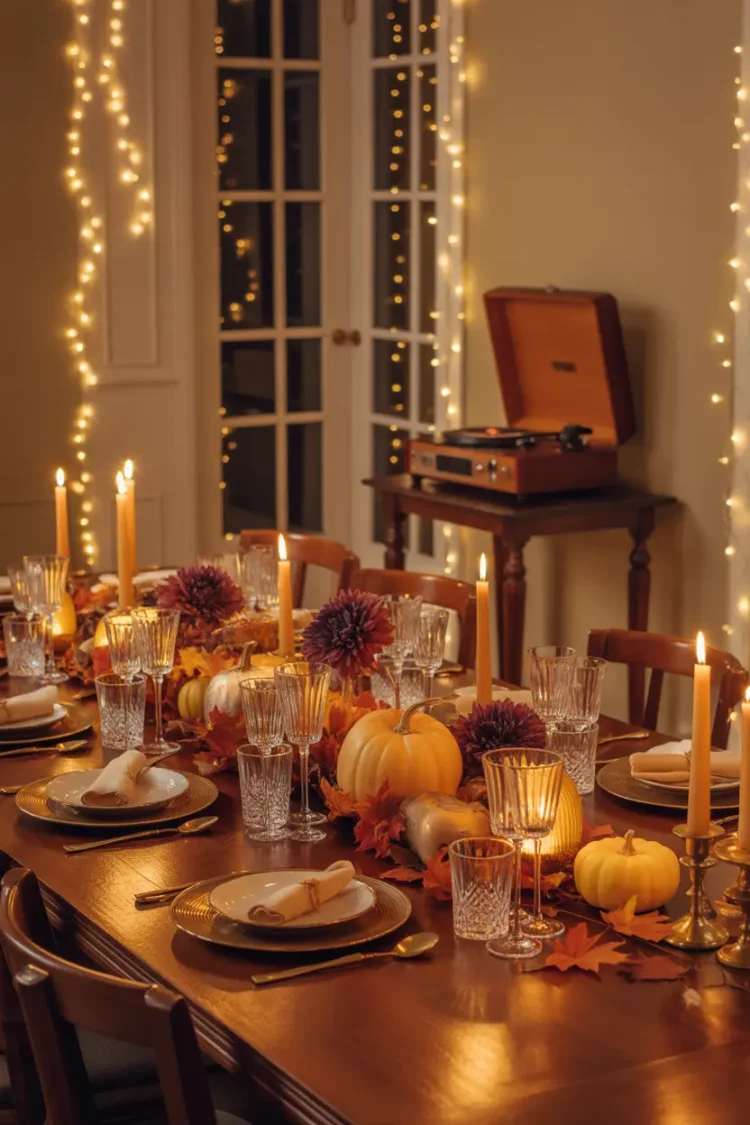Key Takeaways for Memorable Thanksgiving Table Decor
- Focus on simplicity and elegance when designing your table setting
- Incorporate natural elements like seasonal foliage, pumpkins, and gourds
- Layer textures and colors for visual interest and warmth
- Balance decoration with functionality to ensure comfortable dining
- Create a cohesive theme that complements your Thanksgiving menu
- Consider practical space solutions for accommodating larger gatherings
- Use ambient lighting like candles to create a warm atmosphere
- Add personalized touches to make guests feel special
- Plan your table layout with traffic flow and serving style in mind
- Embrace sustainable decorating options that can be reused or repurposed
- Document your beautiful creation with quality photographs to preserve memories
- Remember that the ultimate purpose is to foster connection and gratitude
The Evolution of Thanksgiving Table Decor: From Pilgrim Times to Modern Celebrations
The tradition of decorating the Thanksgiving table has changed a lot since the first celebration between Pilgrims and Wampanoag Native Americans in 1621. That first feast probably had very few decorations and was mainly about the food. Today’s Thanksgiving tables show off our creativity, personal style, and family traditions. The original three-day harvest celebration was mostly practical, focusing on being thankful for survival and good crops rather than how things looked.
In early America, Thanksgiving tables were decorated simply with whatever nature provided—dried corn, nuts, and autumn leaves. Families gathered around tables that were more about food than style. The few decorations served double duty—cornucopias held real food, candles provided necessary light, and tablecloths protected wooden surfaces. As America grew wealthier in the 18th and 19th centuries, fancier table settings with fine china, silver candlesticks, and linen tablecloths became common among those who could afford them. These nicer settings showed both growing wealth and Thanksgiving becoming a more formal holiday.
The Victorian era brought more attention to home decor, with Thanksgiving tables featuring fancy centerpieces, place cards, and special serving dishes. This period introduced specialized dishes, fancy folded napkins, and themed decorations that celebrated fall’s bounty in more stylized ways. Etiquette books gave detailed instructions for proper table setting, making Thanksgiving table decor an art form practiced by the middle and upper classes. By the mid-20th century, magazines and newspapers regularly offered ideas for seasonal table arrangements. The prosperity after World War II saw the rise of matching dinnerware, coordinated table linens, and store-bought Thanksgiving decorations.
Today, we mix traditional elements with modern styles, creating Thanksgiving tables that honor the past while looking fresh and current. Modern tables might feature family silver alongside handmade pottery, vintage linens with contemporary napkin folds, or traditional turkey designs reimagined in simpler, cleaner styles. The 21st century has brought renewed interest in handmade and personal elements, with many hosts creating custom place cards, hand-lettered menus, or DIY centerpieces that tell their family’s unique story. Social media platforms like Instagram and Pinterest have changed table decor completely, giving endless inspiration and encouraging creative table designs. These platforms have made sophisticated design ideas available to everyone, regardless of budget or location.
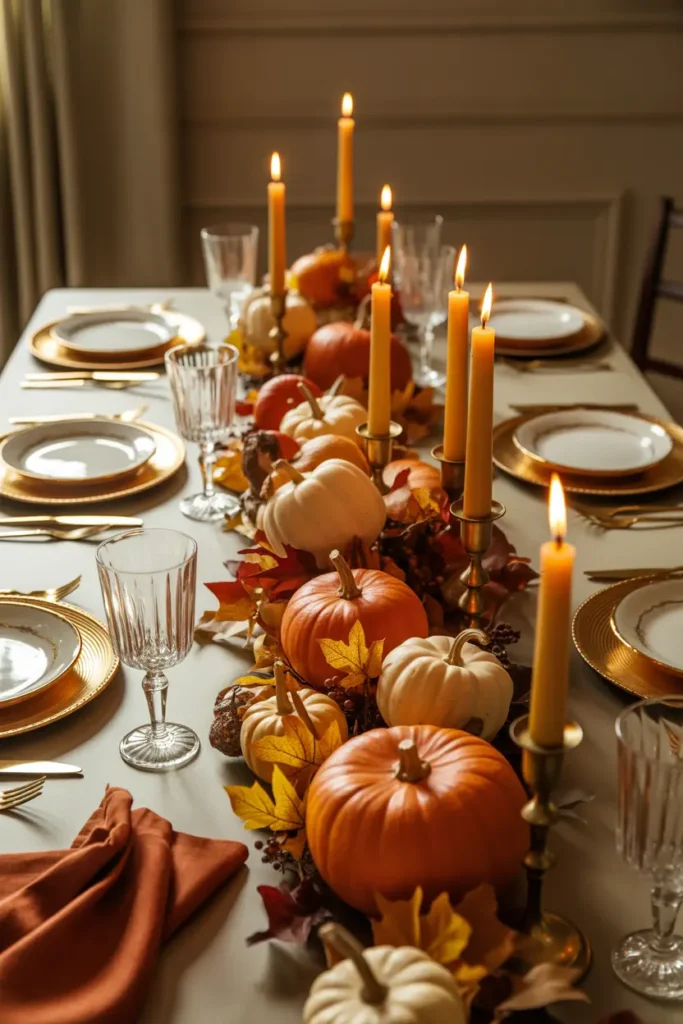
As we explore Thanksgiving table decor, remember that planning the perfect Thanksgiving dinner involves more than just the food—it’s about creating an entire experience that delights all the senses and makes memories that last a lifetime. The thoughtful integration of meaningful decorative elements transforms a simple meal into a significant celebration, honoring both the historical roots of the holiday and your family’s unique traditions.
Natural Elements: The Foundation of Stunning Thanksgiving Tables
Natural elements are the backbone of great Thanksgiving table decor, connecting us to the harvest season and creating a welcoming atmosphere. These items not only look good but also bring the real spirit of being thankful for nature’s gifts. Using things from the natural world grounds your table design in the fall season, creating a connection to the farming heritage that Thanksgiving celebrates. The textures, colors, and shapes of natural materials bring a realness that store-bought decorations just can’t match.
Seasonal Foliage and Botanicals
Using seasonal greenery creates an instant connection to the autumn landscape. Consider arrangements featuring:
Eucalyptus branches have a silvery-green color and wonderful smell that fills the air during your gathering. Different types of eucalyptus—silver dollar, seeded, or spiral—offer various textures and shapes that can be mixed or used alone for different looks. Magnolia leaves have glossy tops and velvety bottoms that add sophisticated texture and dramatic contrast. These sturdy leaves stay looking good for weeks without water, making them perfect for arrangements you want to make ahead of time. Oak and maple leaves in rich fall colors capture the essence of the season. You might want to preserve especially beautiful leaves by pressing them between books or dipping them in beeswax to keep their vibrant colors throughout your gathering. Wheat stalks and dried grasses add height and movement, creating visual interest in static arrangements. These elements catch light beautifully and move slightly with air currents, bringing your table decorations to life. Pine branches and pinecones add a woodland feel with fragrance and texture variety. The smell of pine creates an immediate connection to the season and goes well with the smells of traditional Thanksgiving foods.
These natural elements can be arranged down the center of your table, tucked into napkin rings, or clustered around candles and serving pieces. For a unified look, try collecting foliage from your own yard or nearby parks (where allowed) to bring your local landscape to your table. Gathering locally not only creates a sense of place but also ensures your decorations reflect the actual seasonal changes happening in your area, connecting your celebration to where you live.
Pumpkins, Gourds, and Seasonal Produce
Nothing says Thanksgiving quite like the iconic shapes and colors of pumpkins and gourds. These versatile decorative elements come in countless varieties:
Mini white pumpkins create a modern, elegant look that works with almost any color scheme. Their neutral color lets them work with both traditional autumn colors and more modern color combinations, making them very versatile decorations. Warty gourds with unusual shapes add visual interest that creates conversation pieces and adds fun character to your table. These distinctive gourds celebrate nature’s beautiful imperfections and add personality to more formal arrangements. Classic orange pumpkins in various sizes instantly communicate the harvest season and Thanksgiving tradition. Their bright color creates warming visual impact and pairs beautifully with blues, purples, and greens for unexpected color combinations. Striped and speckled varieties add pattern and texture that create visual complexity to single-color arrangements. These distinctive markings create natural decoration that needs no embellishment to make a statement. Butternut, acorn, and delicata squash have beautiful forms and colors that bridge the gap between decoration and food. Using edible elements in your decor connects beauty with the practical purpose of the Thanksgiving feast.
Consider hollowing out medium-sized pumpkins to create natural vases for flower arrangements or tea light holders for a magical glow. Smaller ones can be placed at each setting as place card holders or party favors. For a bountiful look, mix fruits like pomegranates, pears, and apples among your gourd display. These edible decorations can later be used in post-Thanksgiving meals, reducing waste while extending the celebration of abundance beyond the main event.
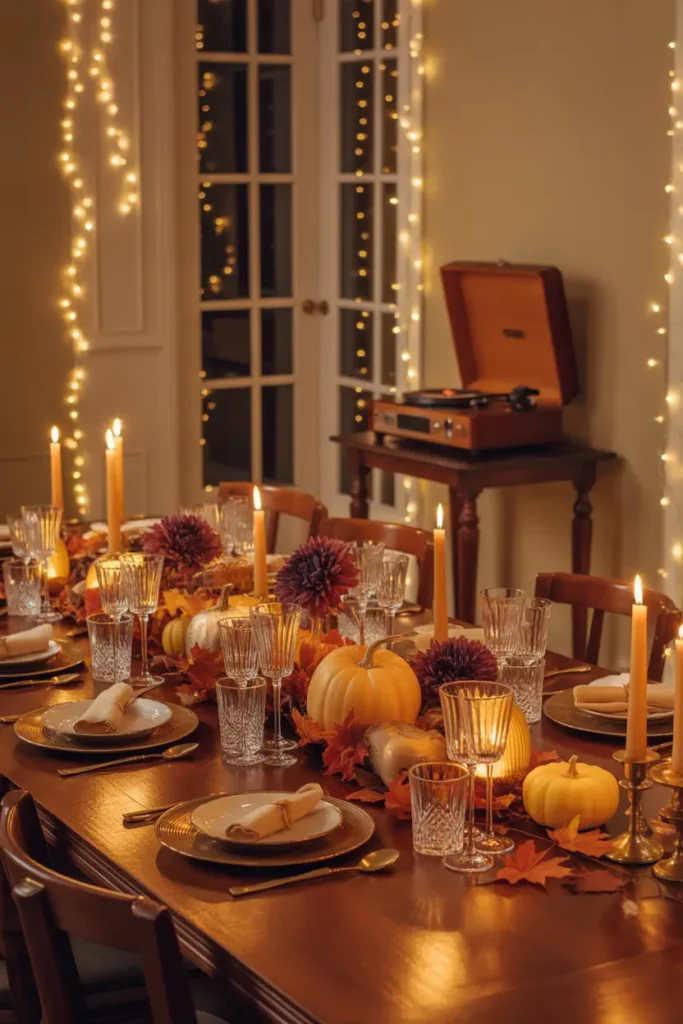
When planning your Thanksgiving feast, remember that easy Thanksgiving dinner planning includes considering how your table decor will complement your menu. Natural elements not only beautify your table but can also hint at the seasonal ingredients featured in your dishes, creating a harmonious visual connection between your decorative choices and culinary offerings. This thoughtful coordination enhances the overall sensory experience, making your Thanksgiving celebration more cohesive and memorable.
Color Schemes and Themes for Thanksgiving Tables
Choosing the right color palette and theme for your Thanksgiving table creates a unified, intentional look that makes the entire dining experience better. The colors you pick set the mood and feeling for your gathering, while a unified theme brings personality and meaning to your celebration. Color psychology affects how your table arrangement will make guests feel—warm colors create closeness and comfort, while cooler colors can feel refreshing and sophisticated. A well-planned color scheme guides all your other decorating decisions, from tablecloths to flowers to serving dishes.
Traditional Autumn Palettes
The classic Thanksgiving color scheme comes directly from nature’s fall display:
Rich oranges like pumpkins and changing leaves create warmth and energy at the table. This bright color ranges from light tangerine to deep burnt sienna, offering many variations that can be layered together for depth. Orange naturally encourages conversation and appetite, making it great for a gathering centered around food and friendship. Deep reds like cranberries and maple trees add dramatic intensity and a sense of luxury to your table. From bright cranberry to deep burgundy, these colors create a sense of abundance and celebration that perfectly captures the festive nature of Thanksgiving. Red also works well as an accent color that draws attention to special parts of your table design. Warm browns like earth and harvested fields ground your color palette with natural stability and comfort. From light tan to deep chocolate, brown creates a sense of reliability and tradition that honors Thanksgiving’s historical roots. These neutral colors also provide perfect background colors that allow other elements to stand out. Golden yellows reflecting autumn sunlight and corn husks bring optimistic brightness to your color scheme. These tones range from pale butter to rich amber, introducing cheerfulness and prosperity to your table. Yellow naturally catches the eye, making it excellent for highlighting specific decorative elements. Forest greens providing contrast and life bring natural vitality to autumn’s warmer colors. These deeper greens represent endurance through the coming winter and provide a perfect complementary color to the reds and oranges in traditional autumn palettes.
These traditional colors can be used in tablecloths, dishes, candles, and decorative elements. For a sophisticated take on this classic palette, consider using muted versions of these colors—terracotta instead of bright orange, burgundy rather than vivid red, and olive in place of forest green. These subdued variations maintain the seasonal feeling while creating a more elegant, less expected interpretation of autumn’s traditional colors.
Modern and Unexpected Color Combinations
While traditional autumn colors will always have their place, contemporary Thanksgiving tables often feature unexpected color combinations:
Dusty blues paired with copper and bronze metallics create a sophisticated, modern take on Thanksgiving decor. This unexpected combination maintains a seasonal feeling through metallic warmth while introducing the calming properties of blue. The contrast between cool and warm tones creates visual tension that keeps the eye moving across your table. Plum and lavender with silver accents offer a regal, luxurious interpretation of autumn colors. These purple tones maintain the richness associated with fall while stepping away from expected colors. The addition of silver brings brightness and light-reflecting properties that lift the entire arrangement. Black and white with touches of gold for dramatic contrast creates a bold, graphic look that feels both modern and timeless. This high-contrast approach allows the textures and shapes of your decorative elements to take center stage, while gold accents add necessary warmth to prevent the scheme from feeling too stark. Monochromatic schemes using various shades of a single color create sophisticated, cohesive tables that rely on textural variation for interest. Consider ranges of olive green, varying shades of copper, or multiple tones of deep blue for unexpected yet seasonally appropriate palettes. All-white arrangements with textural elements for subtle sophistication create a clean, fresh approach to Thanksgiving decor. This palette allows the forms and textures of natural elements to shine without color competition, creating an elegant, restrained aesthetic.
These modern palettes can create memorable, Instagram-worthy tables that surprise and delight guests while still honoring the seasonal spirit of Thanksgiving. When working with non-traditional color schemes, incorporate plenty of natural elements and textures to maintain the connection to harvest traditions.
Thematic Approaches to Table Design
Beyond color schemes, considering an overall theme can guide your decor choices and create a cohesive story:
Rustic farmhouse: Featuring wooden elements, mason jars, and homespun textures that celebrate America’s agricultural heritage. This approach emphasizes authenticity and simplicity, with a focus on natural materials and handcrafted elements. Weathered woods, galvanized metal, and textural linens create a warm, unpretentious atmosphere that invites guests to relax and connect. Elegant harvest: Incorporating fine china, crystal, and sophisticated botanical arrangements for a more formal interpretation of Thanksgiving traditions. This approach makes the celebration special through refined materials and careful attention to detail, creating a sense of special occasion. Metallic accents, quality linens, and structured arrangements create a sense of abundance through refinement rather than quantity. Woodland wonder: Showcasing moss, pinecones, mushroom motifs, and forest-inspired elements that connect your celebration to the natural world. This theme brings the outdoors in, creating an enchanted atmosphere through organic materials and nature-inspired forms. Incorporating elements like bark, lichen, and forest fruits creates a multi-sensory experience that feels both magical and grounded. Global gratitude: Blending traditional American Thanksgiving elements with decor reflecting your family’s cultural heritage creates a personally meaningful celebration. This approach acknowledges that gratitude transcends cultural boundaries while honoring the diverse backgrounds that make up American families today. Incorporating textiles, serving pieces, or decorative elements from your ancestral traditions creates a unique table that tells your family’s specific story. Minimalist abundance: Focusing on negative space with carefully chosen, impactful decorative moments creates a contemporary, thoughtful approach to Thanksgiving decor. This theme celebrates the principle that “less is more,” allowing each element room to breathe and be appreciated. Quality materials, perfect execution, and intentional placement characterize this sophisticated approach.
When selecting a theme, consider what matches your personal style and the atmosphere you want to create. The most successful Thanksgiving tables reflect the host’s personality while making guests feel welcomed and valued.
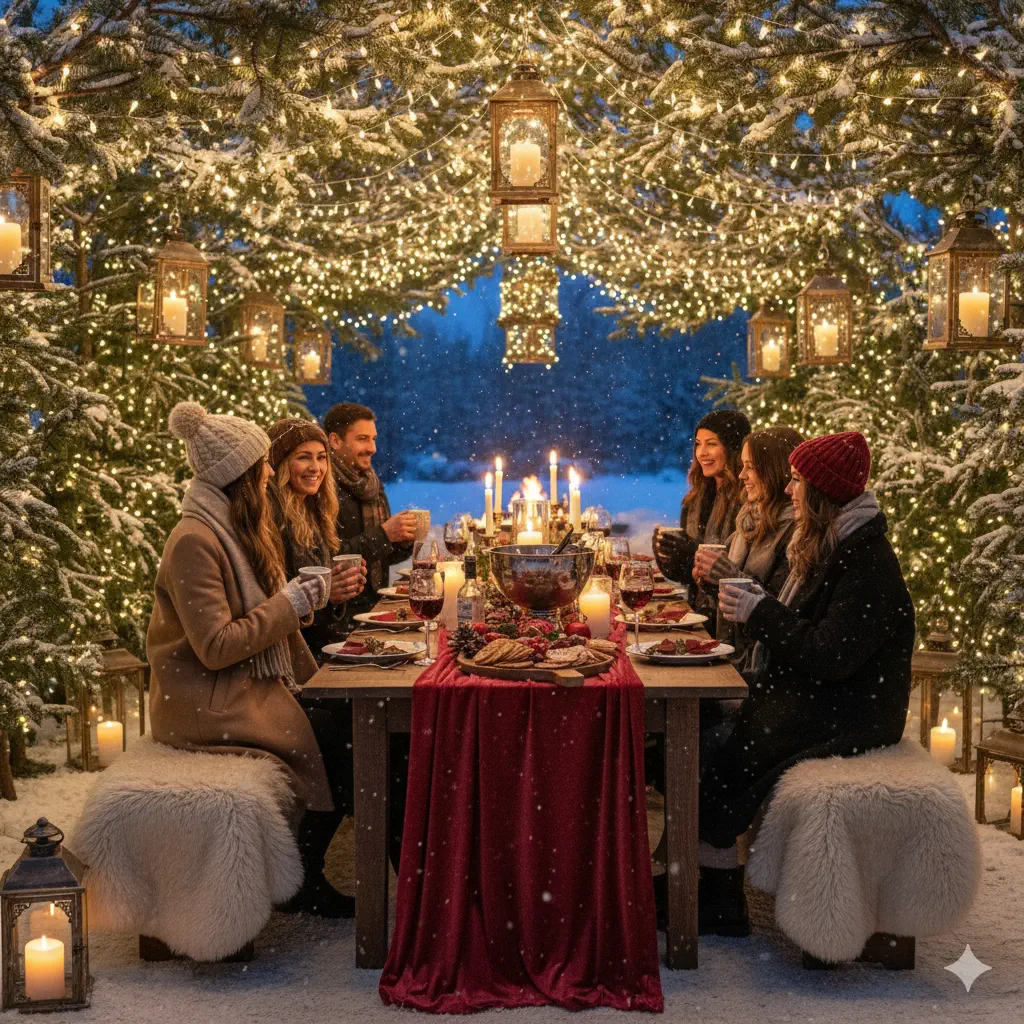
“The best Thanksgiving tables aren’t just beautiful—they’re meaningful. They tell a story about who we are, what we value, and the traditions we hold dear.”— Thanksgiving hosting wisdom
For a complete Thanksgiving experience, pair your thoughtfully designed table with simple, quick appetizers that allow you to spend less time in the kitchen and more time enjoying your beautifully decorated space with loved ones. The connection between your visual presentation and culinary offerings creates a holistic experience that engages all the senses.
Table Linens and Place Settings: Creating Layers of Interest
The foundation of any memorable Thanksgiving table begins with thoughtfully chosen linens and carefully arranged place settings. These elements not only serve practical purposes but also establish the visual framework for your entire table design. The tablecloths and dishes you select create both the literal and figurative foundation for your entire design, setting the tone for the dining experience while expressing your personal style and attention to detail. Quality linens and well-considered place settings tell guests that this meal is special and worth celebrating.
Selecting and Styling Tablecloths and Runners
Your choice of table covering sets the tone for your entire design:
Tablecloths provide complete coverage and a clean slate for your decorative elements. Consider these options:
Classic white or ivory linens for a timeless, elegant foundation that allows other decorative elements to shine. These neutral options create a bright, clean backdrop that makes food colors pop and works with any decorative scheme. High-quality white linens can be dressed up or down, making them versatile investments that serve multiple entertaining needs throughout the year. Natural linen in oatmeal or flax tones for organic warmth that introduces subtle texture and a casual sophistication. These natural fibers bring an artisanal quality to your table and often improve with age, developing character and softness over time. The slightly irregular texture of linen catches light beautifully and creates visual interest even in single-color schemes. Patterned cloths featuring subtle autumn motifs or textural weaves add personality while maintaining sophistication. Look for patterns that incorporate seasonal elements without being overly literal—subtle leaf impressions, abstract harvest motifs, or textural plaids that suggest cozy autumn comfort without becoming themed or cartoonish. Colored tablecloths in your chosen palette to anchor the entire design with a bold foundation. Deep jewel tones like burgundy, forest green, or sapphire blue create dramatic impact, while softer hues like terracotta, sage, or gold offer more subtle seasonal references.
Table runners offer versatility and can be used alone on wooden tables or layered over tablecloths:
Burlap or jute runners for rustic charm that introduces natural texture and casual warmth. These materials bring an earthy, organic quality to your table and pair beautifully with both formal and casual elements, creating interesting textural contrasts. Velvet runners in jewel tones for luxurious texture that adds rich depth and tactile interest. The light-absorbing quality of velvet creates visual richness and invites touch, adding a sensory dimension to your table design. The slight height of the pile also creates subtle shadows and dimension. Embroidered or hand-printed runners for artisanal character that showcases craftsmanship and attention to detail. These unique textiles often tell visual stories through their patterns and can become conversation pieces that engage guests in the narrative of your design choices. Natural elements like eucalyptus garlands or magnolia leaf arrangements as living runners that bring nature directly to your table. These botanical runners create immediate seasonal connection and can be prepared days in advance, particularly when using hardy foliage varieties that maintain their appearance without water.
For an unexpected approach, consider unconventional table coverings like kraft paper (which can double as an interactive element where guests write what they’re thankful for), vintage quilts, or even beautiful autumn-colored scarves repurposed as runners. These unconventional choices add personality and can become signature elements that guests associate with your unique hosting style.
Layering Dinnerware for Visual Impact
Creating layered place settings adds dimension and interest to your table:
Base layers establish your foundation: – Chargers in metallic finishes, wood, or woven materials create a defined space for each guest while adding textural interest and color. These larger-than-dinner-plate elements frame the entire place setting and can introduce complementary colors or finishes that enhance your overall scheme. – Placemats in complementary colors or interesting textures provide definition while protecting your table surface. Consider materials like leather, woven grasses, cut felt, or quilted fabrics for unexpected textural elements that complement your overall design approach. – Larger dinner plates that coordinate with your overall scheme serve as both functional elements and design components. Consider plates with subtle rims, interesting glazes, or textural elements that add visual interest without competing with food presentation.
Middle layers add personality: – Salad or appetizer plates in contrasting colors or patterns create visual interest through juxtaposition. This layer offers an opportunity to introduce complementary colors, unexpected patterns, or thematic elements that might be too bold for larger serving pieces. – Vintage plates mixed with modern pieces for eclectic charm create a collected-over-time feeling that suggests family history and cherished traditions. This approach works particularly well for Thanksgiving, a holiday centered around heritage and the passing of traditions through generations. – Seasonal motifs like turkey or leaf-shaped dishes used sparingly add thematic elements without overwhelming the design. The key is moderation—one or two specialty pieces make a statement, while too many can create a cluttered, theme-park feeling.
Top layers finish the look: – Small bread plates or decorative bowls add functional serving options while completing the visual layering. These top elements often sit slightly offset from the central stack, creating asymmetry that adds visual movement to each place setting. – A seasonal token like a mini pumpkin or pear introduces natural elements and can serve as both decoration and potential take-home favor. These items create height and dimension while reinforcing your seasonal theme. – A personalized place card or menu adds a customized touch that makes each guest feel specially acknowledged. This top layer serves both practical and decorative purposes, guiding seating arrangements while adding a finishing design element.
Remember that while elaborate layering creates visual interest, it should still be practical for dining. Consider how each element will function during the meal and remove purely decorative items before serving. The most successful layered place settings balance looking good with being practical, enhancing rather than complicating the dining experience.
Napkin Styling and Place Card Ideas
Thoughtfully presented napkins add polish to each place setting:
Napkin folds range from simple to elaborate: – The classic triangle fold tucked under the fork offers timeless elegance with minimal effort. This traditional approach works with any napkin material and maintains a clean, sophisticated look appropriate for formal gatherings. – Pocket folds that hold place cards or small sprigs of herbs combine functionality with decorative impact. These practical folds create natural housing for additional elements while adding structural interest to your place setting. – Fan or bishop’s hat folds for elegant height that creates dimensional interest and formal flair. These more elaborate folds showcase beautiful napkin fabrics and create sculptural elements that elevate the entire place setting. – Simple napkin rings adorned with natural elements like cinnamon sticks or small pine cones add textural interest while keeping napkins neatly contained. These can be prepared well in advance and offer an opportunity to introduce additional natural materials to your table design.
Place card options help guests find their seats while adding decorative flair: – Calligraphy on small cards nestled in pinecones or mini pumpkins combines natural elements with personalized details. The contrast between organic materials and refined handwriting creates compelling visual interest. – Herbal sprigs with names written on small attached tags introduce fragrance and natural elements while clearly marking place assignments. Consider rosemary, bay leaves, or sage for seasonal herbs that complement traditional Thanksgiving aromas. – Ornamental fruits like pears with names written directly on the skin create edible place cards that reduce waste while adding natural beauty. Using metallic pens on darker-skinned fruits creates particularly striking results. – Small seasonal cookies or treats with attached name flags combine place cards with pre-dinner nibbles. These edible place markers create immediate engagement and appreciation from guests. – Miniature photo frames with each guest’s name offer keepsake potential while clearly marking seating arrangements. Consider using photos of guests from previous gatherings for a nostalgic touch that celebrates your shared history.
For a personal touch that celebrates gratitude, consider including a small note at each place expressing what you appreciate about that specific guest, or provide beautiful cards where diners can write what they’re thankful for to share during the meal. These interactive elements transform place settings from purely decorative to emotionally meaningful, enhancing the gratitude focus that defines Thanksgiving.
When coordinating your table linens and place settings with your Thanksgiving recipes, consider how the colors and textures will complement the food you’ll be serving. A thoughtfully designed table enhances the dining experience and makes your culinary creations shine. The most successful table designs consider the visual presentation of the specific dishes being served, ensuring that the food and tableware work in harmony to create a cohesive sensory experience.
Centerpieces and Focal Points: The Heart of Your Table Design
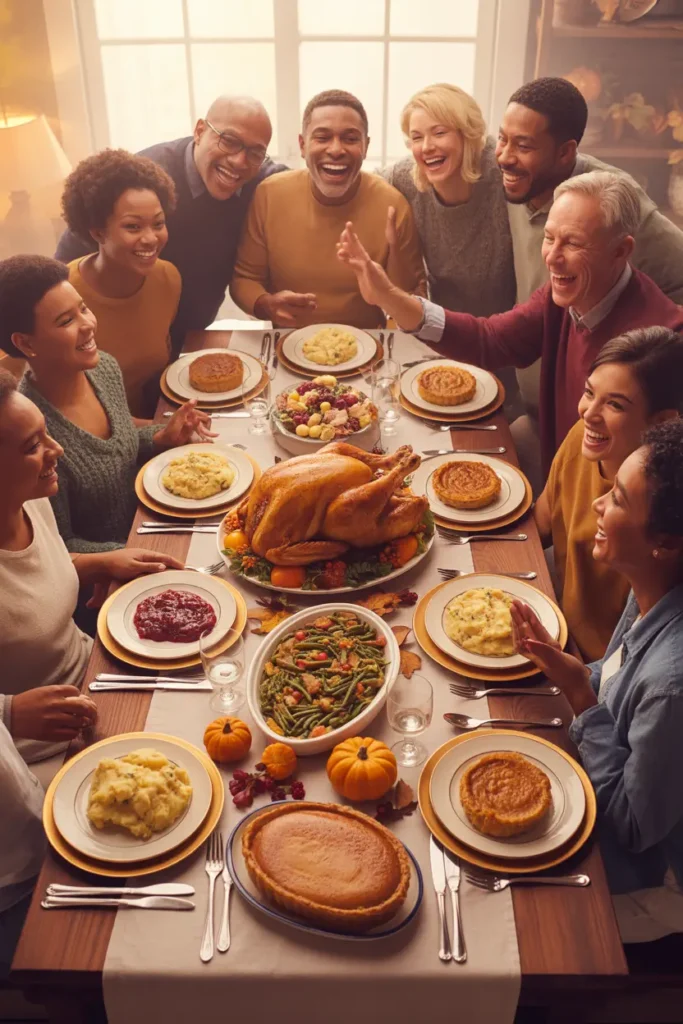
The centerpiece of your Thanksgiving table serves as its visual anchor, drawing the eye and setting the tone for your entire gathering. Whether elaborate or simple, your chosen focal point should reflect the spirit of the holiday while remaining practical for a dining experience. A thoughtfully designed centerpiece creates immediate impact when guests enter the dining space, establishing the mood and aesthetic direction for your celebration. Unlike everyday table arrangements, Thanksgiving centerpieces often tell a story about abundance, harvest, and gratitude through their composition and elements.
Traditional and Contemporary Centerpiece Ideas
Traditional centerpieces honor time-tested Thanksgiving aesthetics:
Cornucopias filled with seasonal fruits, vegetables, and flowers symbolize abundance and thanksgiving in their most literal form. This classical horn of plenty directly references historical harvest celebrations and creates an immediately recognizable seasonal statement. Modern interpretations might use metallic or woven cornucopias with artfully arranged contents that coordinate with your color scheme. Arrangements of pillar candles in varying heights surrounded by autumn leaves create warm, flickering light that enhances the intimate feeling of Thanksgiving gatherings. The combination of illumination and natural elements creates both practical lighting and seasonal decoration. Consider grouping candles in odd numbers on a mirrored or metallic tray to amplify their glow. Classic floral displays featuring chrysanthemums, dahlias, and roses in fall hues bring traditional floral beauty to your table. These structured arrangements connect to Victorian and early 20th century Thanksgiving traditions when formal floral centerpieces became popular. For a modern update, consider looser, more organic arrangements that maintain traditional flowers but present them in more contemporary compositions. Tiered stands holding seasonal fruits, nuts, and small decorative elements create vertical interest while maximizing table space. These multi-level displays allow for abundant decoration without consuming excessive table width, making them practical for smaller tables or larger gatherings. The elevation also creates natural hierarchy and focal points within the arrangement. Vintage turkey figurines or other Thanksgiving collectibles celebrate the nostalgic aspects of the holiday while adding personality and potential family history. These character pieces often become beloved traditions passed through generations and can spark conversations about Thanksgivings past.
Contemporary centerpieces offer fresh interpretations of holiday themes:
Asymmetrical arrangements featuring unexpected elements like artichokes or kale bring modern composition principles to traditional materials. These less structured arrangements feel fresh and artistic while maintaining connections to harvest themes through their natural components. The deliberate imbalance creates dynamic visual interest that draws the eye across the table. Monochromatic displays using a single type of flower or botanical in abundance create sophisticated impact through simplicity and repetition. This approach feels modern and intentional while allowing the intrinsic beauty of natural forms to shine. Consider masses of white pumpkins, all-green arrangements, or collections of objects in varying shades of a single metallic finish. Geometric terrariums filled with succulents and small pumpkins combine contemporary container styles with traditional elements. These structured vessels create contained vignettes that require minimal table space while adding architectural interest. Their clear sides allow visibility across the table while still providing decorative impact. Illuminated elements like string lights woven through greenery bring magical sparkle to your centerpiece. These twinkling lights create a festive atmosphere and provide practical illumination that flatters both your decor and your guests. Battery-operated options eliminate cord management concerns and allow for flexible placement. Sculptural branches or driftwood as artistic focal points introduce organic architecture and natural form. These found objects bring the outside world to your table while creating dramatic silhouettes and interesting shadows. Their irregular forms provide contrast to the structured elements of place settings and serving pieces.
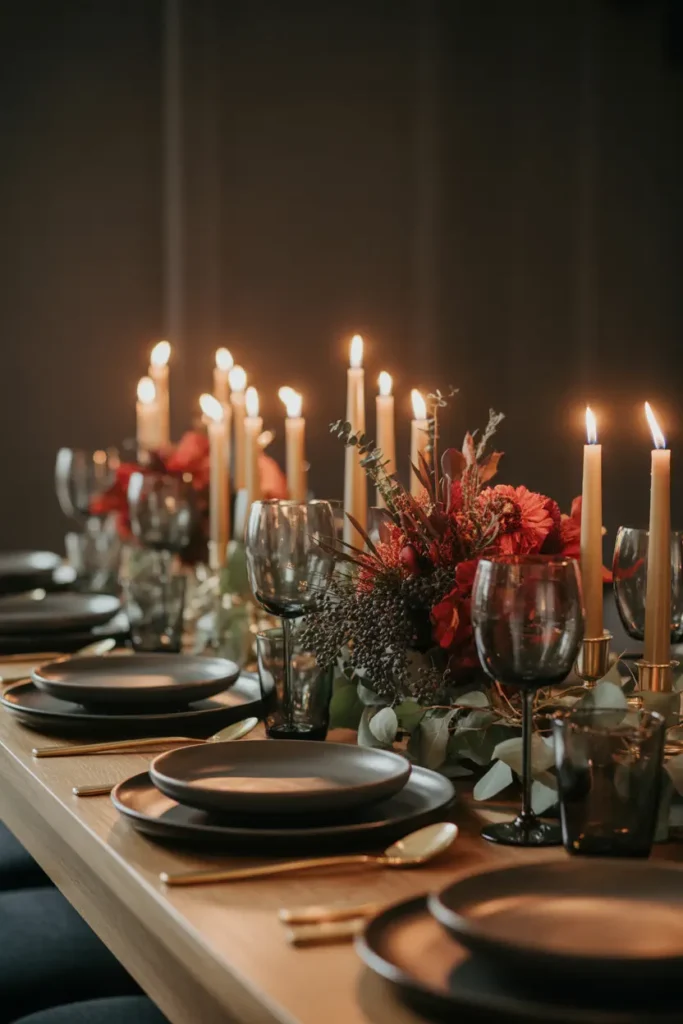
For a truly memorable approach, consider centerpieces that engage multiple senses—arrangements that incorporate fragrant herbs like rosemary and sage, or elements that create gentle sound like ornamental grasses that rustle with movement. Multi-sensory centerpieces create immersive experiences that engage guests on multiple levels, enhancing the overall impact of your table design.
Creating Height and Visual Interest
A dynamic centerpiece incorporates varying heights to create visual rhythm across your table:
Use cake stands, books, or wooden blocks as risers to elevate certain elements, creating levels that guide the eye through your arrangement. These platforms allow you to create dimension without requiring tall elements that might block views. Clear glass or acrylic risers create height while maintaining visual lightness. Incorporate taper candles or tall, slender vases for vertical interest that doesn’t block conversation. These narrow vertical elements create height without visual density, allowing guests to see through and around them while still appreciating their presence. Grouping several slim elements creates more substantial impact than a single tall piece. Arrange elements in a crescendo pattern, building from low at the table ends to higher in the center, creating a visual journey across your tablescape. This graduated approach ensures that no matter where guests are seated, they experience an interesting portion of the overall design. The rhythmic variation creates natural visual movement. Suspend elements above the table using a chandelier or hanging structure adorned with seasonal decorations for dramatic impact that doesn’t consume valuable table space. This approach creates a three-dimensional experience that expands your decorative territory beyond the table surface. Consider hanging elements that can be viewed from multiple angles. Create depth by placing some elements closer to the table edge and others toward the center, establishing foreground, middle ground, and background within your arrangement. This dimensional layering mimics natural landscapes and creates a more immersive visual experience. Varying the distance between elements creates natural pathways for the eye to travel.
When designing with height, maintain a balance that allows guests to see each other across the table. The general rule is that centerpieces should be either below eye level when seated or tall enough to see under, with a clear line of sight maintained. Consider the practical aspects of conversation and connection when determining the height and density of your centerpiece elements.
Balancing Decoration with Functionality
Even the most beautiful centerpiece must work practically for a dining experience:
Create a centerpiece that can be easily moved if necessary to make room for serving dishes, particularly if you’ll be serving family-style. Consider designing your arrangement in sections that can be temporarily separated or repositioned as needed. Placing elements on trays or platters facilitates easy movement without disturbing the entire design. Design in sections that can be temporarily separated to accommodate platters, allowing flexibility while maintaining your overall design concept. This modular approach ensures that your beautiful centerpiece doesn’t become an obstacle during the meal. Practice rearranging components before guests arrive to ensure smooth transitions. Consider the width of your arrangement—leave at least 15 inches of clear space for place settings and serving to ensure comfortable dining without crowding. Measure your table and subtract the necessary functional space before determining the footprint of your centerpiece. Remember that guests need room to comfortably reach serving dishes and cut food without feeling constrained. If using candles, ensure they’re dripless and positioned safely away from flammable decorations to prevent accidents or damage. Consider the height of candle flames in relation to overhanging elements, and always use appropriate holders that catch potential wax drips. Flameless LED candles provide a safe alternative that still creates ambient glow. For fragrant elements, choose subtle scents that won’t compete with food aromas, ensuring that your decorative choices enhance rather than detract from the culinary experience. Save stronger fragrances for areas away from the dining table, and focus on naturally subtle scents like bay leaves, cinnamon sticks, or fresh herbs at the table itself.
For family-style dining where many dishes will occupy the center of the table, consider creating multiple smaller focal points instead of one large centerpiece. Place small arrangements between serving dishes, or focus your decorative energy on the place settings instead. This distributed approach maintains decorative impact while accommodating practical dining needs.
🕯️
Lighting Considerations
Use unscented candles to avoid competing with food aromas. Position at heights that won’t shine directly in guests’ eyes.
🍽️
Space Management
Ensure at least 24″ of table width per person. Leave room for serving dishes and comfortable conversation.
🌿
Living Elements
Incorporate fresh herbs that can double as aromatic garnishes for your Thanksgiving dishes.
Remember that your centerpiece should enhance rather than detract from the true focus of Thanksgiving—gratitude, connection, and the spectacular Thanksgiving dishes you’ve prepared with love. The most successful focal points create beauty while facilitating the shared experience of the meal. A thoughtfully designed centerpiece sets the stage for meaningful connection while expressing the abundance and gratitude that define the Thanksgiving celebration.
DIY Table Decorations: Personal Touches That Create Meaning
Handcrafted elements bring uniqueness and personal significance to your Thanksgiving table, creating connections between past and present while expressing your creativity. These DIY touches often become the most memorable aspects of your holiday decor, sparking conversation and carrying special meaning. Beyond their visual contribution, handmade decorations show thoughtfulness and personal investment in your gathering, showing guests that you’ve dedicated time and care to creating a special experience. The imperfections in handcrafted items add character and authenticity that store-bought decorations simply cannot match.
Handmade Place Cards and Favors
Personalized place cards not only help guests find their seats but also make them feel specially acknowledged:
Nature-inspired place cards: – Pressed autumn leaves with names written in metallic pen create elegant, seasonal markers that connect directly to fall’s natural beauty. The unique shape and veining of each leaf ensures that every place card is one-of-a-kind, much like each guest at your table. Consider collecting leaves from meaningful locations or during family walks to add narrative significance. – Small pine cones with name tags attached by twine bring woodland texture and three-dimensional interest to each place setting. These natural elements can be collected during family outings, creating pre-Thanksgiving memories that become part of your table’s story. Consider dipping the tips in gold or silver paint for a festive touch that maintains natural character. – Sprigs of rosemary or cinnamon sticks tied with ribbon and name tags introduce fragrance and tactile elements that engage multiple senses. These aromatic markers create subtle scent experiences that complement traditional Thanksgiving dishes while clearly marking seating arrangements. Their natural simplicity pairs beautifully with both rustic and elegant table designs. – Smooth stones with names written in calligraphy offer earthy permanence and artistic elegance. These substantial markers have a grounding presence and can become keepsakes that guests take home. Consider collecting stones from meaningful locations or during family travels to add layers of significance.
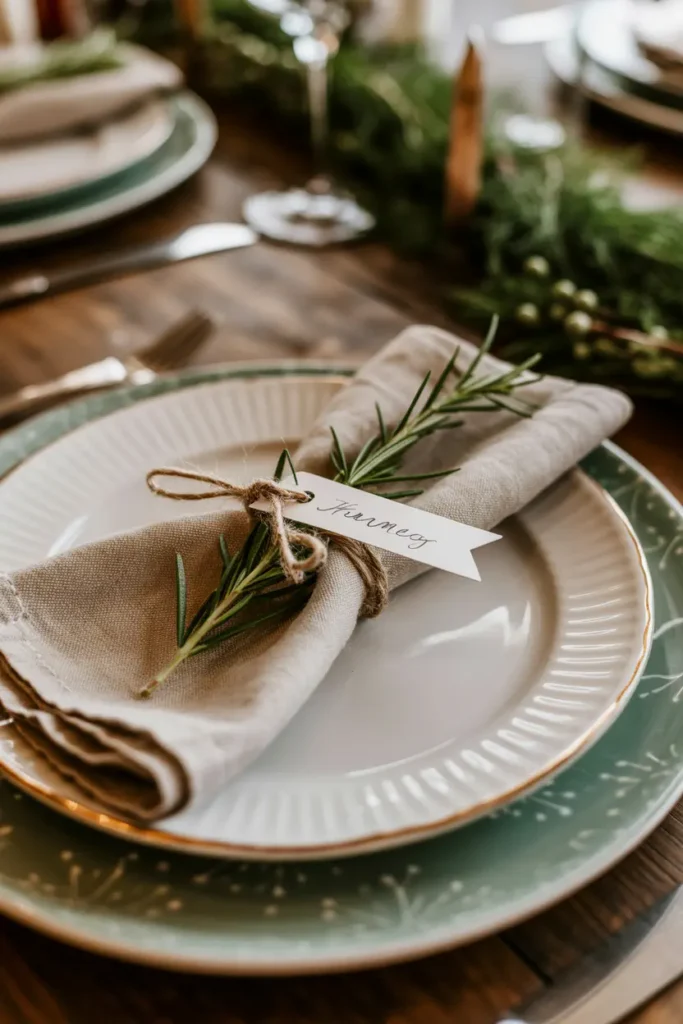
Edible place cards: – Pears or apples with names attached on decorative picks combine function, decoration, and potential dessert in one thoughtful element. These edible markers reduce waste while adding natural beauty to your table. Consider selecting fruit varieties with colors that complement your overall table design. – Cookies shaped like leaves with guests’ names piped in icing create sweet welcome gifts that clearly mark seating arrangements. These edible place cards can be prepared days in advance and double as pre-dinner treats or take-home favors. Consider including your family’s cookie recipe on the back of a place card for guests to recreate at home. – Mini loaves of bread with name tags tied to them offer substantial presence and immediate hospitality. These edible markers signal abundance and sharing, perfect themes for Thanksgiving celebrations. Consider baking loaves with herbs or spices that complement your menu. – Chocolate bark pieces with custom labels combine sweet treats with personalization. These edible markers can be prepared well in advance and customized with additions like dried cranberries, pumpkin seeds, or spices that reflect your Thanksgiving menu.
Favor ideas that double as place cards: – Small potted herbs with name tags on decorative picks offer living gifts that continue growing long after Thanksgiving ends. These sustainable favors connect to the agricultural themes of Thanksgiving while providing practical value for home cooks. Consider herbs commonly used in holiday cooking like sage, thyme, or rosemary. – Miniature jars of honey, jam, or maple syrup with personalized labels combine place cards with take-home treats. These edible favors extend the hospitality of your table beyond the meal itself. Consider locally produced products that reflect your region’s specialties. – Seasonal tea blends in custom packages marked with each guest’s name provide comfort and warmth as the weather turns colder. These thoughtful favors can be enjoyed during the holiday season as a reminder of your gathering. Consider creating custom blends that reflect guests’ preferences or include warming spices like cinnamon and clove. – Handmade ornaments that can adorn the Thanksgiving table before becoming keepsakes create dual-purpose decorations that extend beyond the meal. These lasting favors become annual reminders of your gathering when displayed in future holiday seasons. Consider materials and designs that complement your table theme while having standalone decorative value.
For children’s place settings, consider creating turkey-shaped place cards they can wear as headbands, or small activity packets personalized with their names to keep them entertained before the meal begins. These age-appropriate touches make younger guests feel specially included in the celebration while potentially helping them remain engaged during adult conversation.
Repurposing Household Items for Table Decor
Creating memorable table decor doesn’t require expensive specialty items. Look around your home for objects that can be reimagined:
From the kitchen: – Mason jars transformed into candle holders or vases bring humble utility to decorative purpose. These versatile containers can be left clear or decorated with ribbon, twine, or paint to coordinate with your table design. Their varying sizes create natural hierarchy when grouped together. – Cake stands repurposed as elevated platforms for decorative elements add height and importance to simple items. These pedestals create natural focal points and allow for multi-level arrangements without specialized equipment. Consider stacking stands of different sizes for dramatic vertical impact. – Wooden cutting boards used as serving platters or bases for centerpieces introduce warm, natural texture and practical surfaces. These functional items bring rustic elegance to your table while providing heat-resistant platforms for hot dishes. Their natural variations in grain and color add organic visual interest. – Teacups filled with small flower arrangements for individual place settings create personalized mini-centerpieces that don’t block views. These intimate arrangements can utilize vintage cups, family heirlooms, or collected pieces that tell stories and create conversation. Consider matching cup patterns to specific guests based on their preferences or personalities.
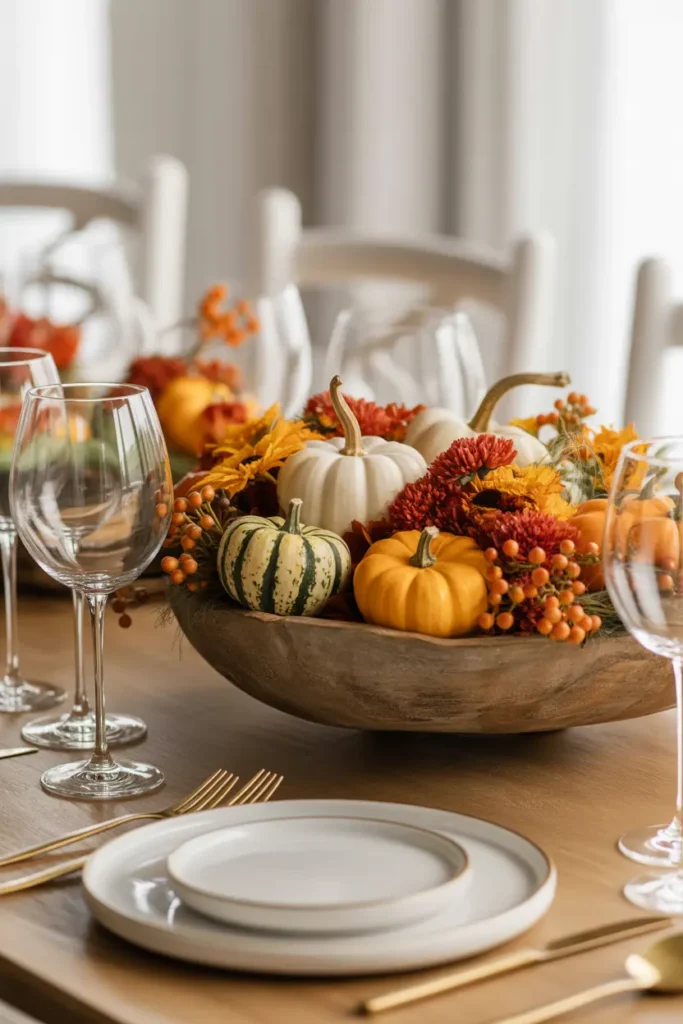
From other rooms: – Books stacked and topped with decorative elements for height variation bring intellectual character and structural stability to arrangements. Consider volumes with thematic connections to gratitude, history, or cooking for conceptual alignment with your Thanksgiving celebration. Book spines can introduce additional color and textural elements to your design. – Picture frames holding seasonal images or gratitude quotes create personalized decor that can be updated for different occasions. Empty frames can also be used architecturally to create defined spaces within larger arrangements. Consider mixing frame styles and finishes for collected, eclectic character. – Scarves or throws used as table runners introduce rich texture and unexpected fabric applications. These soft elements bring warmth and comfort to your table design while repurposing items you already own. Consider seasonal colors or patterns that complement your overall scheme. – Decorative bowls filled with seasonal elements like nuts, pinecones, or ornaments create contained vignettes that can be easily moved if needed. These versatile containers keep loose elements organized while creating defined decorative moments. Their varied heights and shapes add dimensional interest to flat tablescapes.
From the garden or yard: – Branches arranged in tall vases for dramatic height bring the outdoors in and create architectural interest. These free decorative elements can be left natural or embellished with paint, glitter, or small ornaments depending on your aesthetic direction. Their irregular forms create organic movement and visual dynamism. – Rocks used as paperweights for place cards or menu cards add natural weight and textural variety. These found objects connect your table to the earth and introduce elemental contrast to softer decorative components. Consider stones with interesting patterns, colors, or shapes that complement your overall design. – Potted plants temporarily repurposed as living table decor bring vitality and freshness to your arrangement. These sustainable decorations continue living after your celebration, making them both beautiful and practical choices. Consider plants with seasonal colors or textures like small cypress trees, flowering kalanchoe, or variegated ivy. – Fallen leaves pressed between wax paper and used as natural confetti create free, biodegradable decoration with direct seasonal connection. These ephemeral elements bring authentic autumn color and form to your table while celebrating nature’s patterns. Consider creating leaf arrangements on clear plates under glass components for preserved displays.
The beauty of repurposed items lies in their sustainability and the creative vision they represent. These elements often carry stories and history that can enrich your Thanksgiving narrative. Repurposing demonstrates resourcefulness and creativity while reducing consumption—values that align perfectly with Thanksgiving’s historical roots in gratitude and appreciation for available resources.
Creating Family Traditions Through Table Decor
Perhaps the most meaningful DIY decorations are those that become traditions passed through generations:
Gratitude-focused traditions: – A “thankful tree” centerpiece where guests hang notes expressing gratitude creates an interactive focal point that grows more beautiful throughout your gathering. This living documentation of appreciation becomes both decoration and meaningful activity. Consider preserving these notes in a special book that accumulates gratitude year after year. – A special tablecloth where guests sign their names and write what they’re thankful for each year creates a time capsule of sentiments that can be displayed annually. This evolving document becomes more precious with each passing Thanksgiving, recording changing handwriting, growing families, and shifting perspectives on gratitude. Consider using fabric markers on a light-colored cloth for lasting documentation. – A decorative journal that travels from the centerpiece to each place setting for guests to record memories creates a collaborative written history of your gatherings. This shared documentation becomes both activity and keepsake, growing richer with each year’s additions. Consider providing thought-provoking prompts to inspire meaningful reflections. – A ritual of adding a new handmade ornament to the table decor each year creates an evolving collection that tells your family’s story. These accumulated decorations become visual reminders of past gatherings and can eventually be passed to younger generations as meaningful heirlooms. Consider dating each piece to track their history.
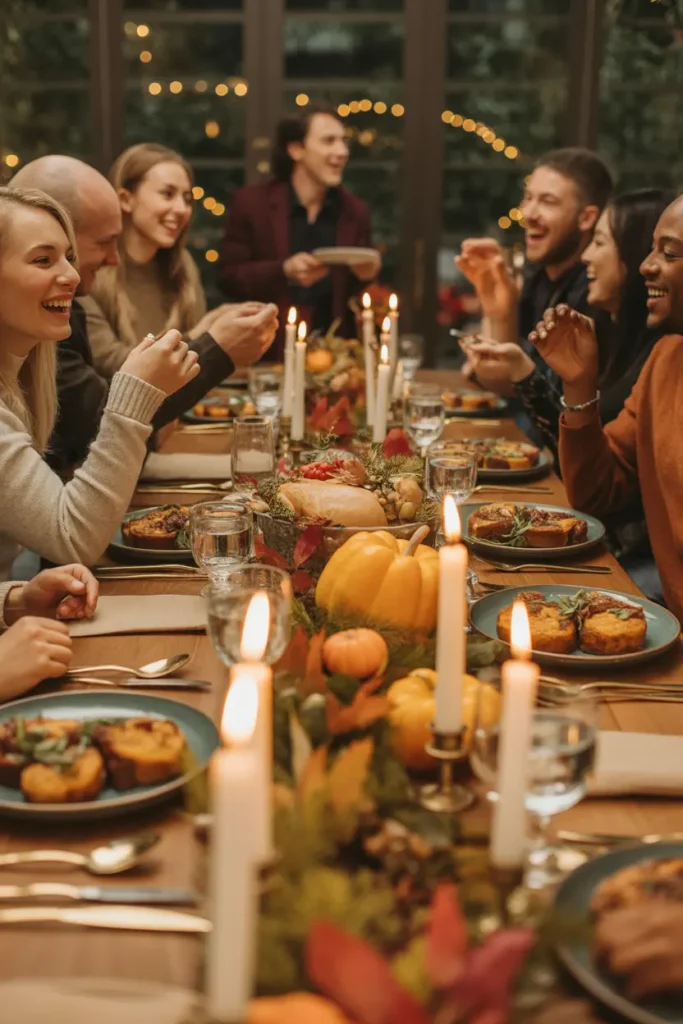
Memory-preserving traditions: – Photo displays incorporated into the table design showing Thanksgivings past create visual continuity between celebrations. These historical references honor absent loved ones and document your family’s evolution. Consider creating small photo booklets at each place setting showing that specific guest at previous Thanksgivings. – Place cards that include favorite memories of each guest create personalized acknowledgments that celebrate shared history. These thoughtful touches demonstrate care and attention while sparking conversations about meaningful moments. Consider asking family members to contribute memories about each guest for more diverse perspectives. – A centerpiece featuring treasured family heirlooms with stories to share creates a museum of meaningful objects that spark conversations about family history. These curated displays honor past generations while educating younger family members about their heritage. Consider creating small written descriptions of each item’s significance. – Menu cards that include the history of special family recipes connect culinary traditions to the people who created them. These documented food histories honor the cultural and personal influences that shaped your Thanksgiving table. Consider including photographs of original recipe cards or the family members who originated special dishes.
Interactive traditions: – Decorative elements that transform during the meal, like place cards that unfold to reveal conversation starters, create dynamic experiences that evolve throughout your gathering. These changing elements maintain interest and engagement while facilitating meaningful interaction. Consider creating elements with multiple functions or revelations. – Centerpieces with elements guests add throughout the gathering create collaborative art that documents your shared experience. These evolving decorations become physical manifestations of your time together. Consider providing materials for guests to create small contributions that combine into a larger whole. – Table runners or placemats guests can write or draw on during the meal create documentary art that captures the spirit of your specific gathering. These interactive textiles become keepsakes that record both intentional messages and spontaneous doodles or notes. Consider providing fabric markers in limited colors for aesthetic cohesion. – Decorative containers where guests place symbolic items representing their year’s journey create physical representations of shared experiences. These collective assemblages honor individual stories while creating unified displays. Consider providing small cards where guests can explain the significance of their contributed items.
Remember that planning for a crowd means considering not just the food but also how your DIY decorations will accommodate your guest list. The most successful handmade elements enhance the experience without overwhelming the practical aspects of serving and enjoying your Thanksgiving meal. Scale your DIY ambitions appropriately to your available preparation time and the specific needs of your gathering.
Printable Recipe Card
Want just the essential recipe details without scrolling through the article? Get our printable recipe card with just the ingredients and instructions.

